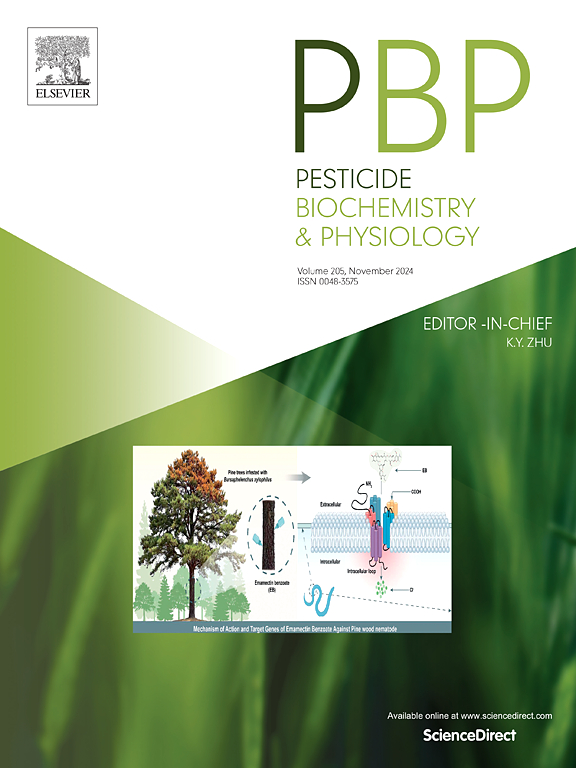Conyza bonariensis resistance to glyphosate and ALS inhibitors involves target and non-target site resistance
IF 4
1区 农林科学
Q2 BIOCHEMISTRY & MOLECULAR BIOLOGY
引用次数: 0
Abstract
Herbicide resistance in Conyza bonariensis (hairy fleabane) poses a significant challenge to agricultural systems worldwide. The genetic variability and prolific seed production of this species contribute significantly to its adaptative potential and fast spread in the agricultural fields. This study aimed to investigate the mechanisms underlying multiple herbicide resistance to glyphosate and ALS inhibitors in C. bonariensis biotypes from southern Brazil. Resistance factors exceeded 100 times for chlorimuron-ethyl and 49 times for glyphosate. DNA Sequencing revealed the target-site mutations Pro106Thr in the EPSPS gene conferring glyphosate resistance, and Pro197Arg and Trp574Leu in the ALS gene contributing to chlorimuron-ethyl resistance. Additionally, the resistance factor decreased at least 80 % for resistant biotypes after application of chlorimuron-ethyl following treatment with the P450 inhibitor malathion, which might indicate enhanced metabolism mediated by cytochrome P450 enzymes. Copy number variation and overexpression of ALS and EPSPS genes were not related to resistance. Biotype II carries the Pro197Arg mutation and exhibited cross-resistance to imazethapyr, diclosulam, bispyribac‑sodium, and flucarbazone‑sodium. Biotypes carrying the Trp574Leu mutation were resistant to imazethapyr, diclosulam and flucarbazone‑sodium but demonstrated varying resistance patterns to bispyribac‑sodium, highlighting the complexity of resistance mechanisms. These findings underscore the importance of understanding both target and non-target-site resistance mechanisms to develop effective management strategies, including herbicide rotation and molecular diagnostics, to mitigate the spread of herbicide-resistant C. bonariensis in agricultural systems.

Conyza bonariensis对草甘膦和ALS抑制剂的抗性包括靶点和非靶点抗性
毛蚤(Conyza bonariensis)的除草剂抗性对全球农业系统构成了重大挑战。该品种的遗传变异和多产的种子产量是其适应潜力和在农业领域快速传播的重要因素。本研究旨在探讨巴西南部bonariensis生物型对草甘膦和ALS抑制剂的多重除草剂抗性机制。对氯脲乙基和草甘膦的抗性因子分别超过100倍和49倍。DNA测序结果显示,EPSPS基因中的Pro106Thr突变导致草甘膦抗性,ALS基因中的Pro197Arg和Trp574Leu突变导致氯脲-乙基抗性。此外,在P450抑制剂马拉硫磷处理后,施用氯脲乙基后,耐药生物型的耐药因子降低了至少80%,这可能表明细胞色素P450酶介导的代谢增强。ALS和EPSPS基因的拷贝数变异和过表达与抗性无关。生物型II携带Pro197Arg突变,并表现出对imazethapyr、双氯sulam、bispyribac -钠和氟卡巴酮-钠的交叉抗性。携带Trp574Leu突变的生物型对imazethapyr、双氯sulam和氟卡巴酮钠耐药,但对双嘧菌酯钠的耐药模式不同,突出了耐药机制的复杂性。这些发现强调了了解靶点和非靶点抗性机制对于制定有效的管理策略(包括除草剂轮作和分子诊断)的重要性,以减轻耐除草剂bonariensis在农业系统中的传播。
本文章由计算机程序翻译,如有差异,请以英文原文为准。
求助全文
约1分钟内获得全文
求助全文
来源期刊
CiteScore
7.00
自引率
8.50%
发文量
238
审稿时长
4.2 months
期刊介绍:
Pesticide Biochemistry and Physiology publishes original scientific articles pertaining to the mode of action of plant protection agents such as insecticides, fungicides, herbicides, and similar compounds, including nonlethal pest control agents, biosynthesis of pheromones, hormones, and plant resistance agents. Manuscripts may include a biochemical, physiological, or molecular study for an understanding of comparative toxicology or selective toxicity of both target and nontarget organisms. Particular interest will be given to studies on the molecular biology of pest control, toxicology, and pesticide resistance.
Research Areas Emphasized Include the Biochemistry and Physiology of:
• Comparative toxicity
• Mode of action
• Pathophysiology
• Plant growth regulators
• Resistance
• Other effects of pesticides on both parasites and hosts.

 求助内容:
求助内容: 应助结果提醒方式:
应助结果提醒方式:


